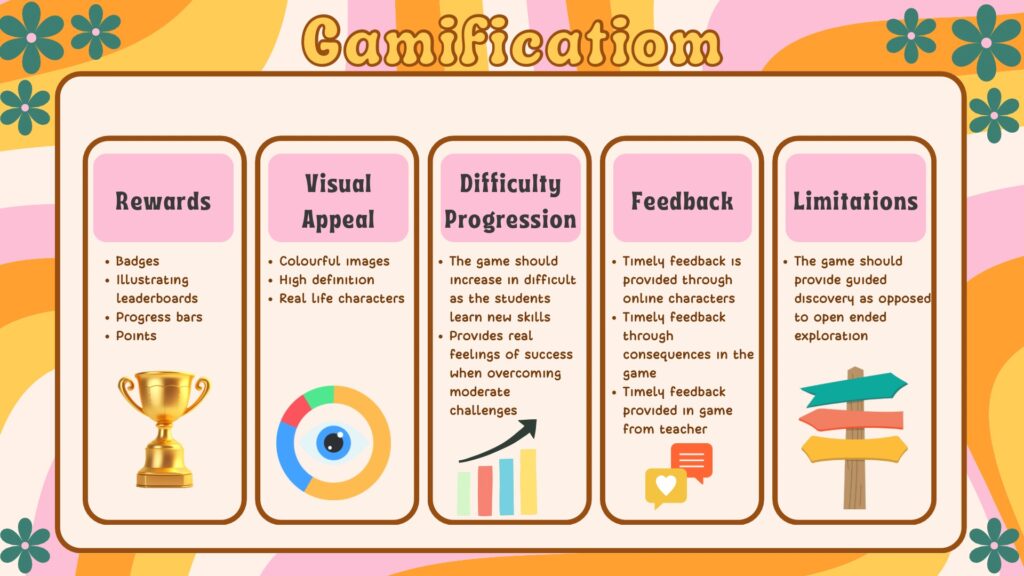Hello Blog, we’ve made it to my last reflection post which is going to be taking all about gamification and specifically looking at the online game-based learning platform – Prodigy.
Gamification:
To start, what is gamification? Gamification is the practice of making activities more like games in order to make them more interesting or enjoyable. So, why is this important for educators to consider? Well, as educators, it is our responsibility to consider what approaches we can take to enhance student learning – targeting ways to make learning more engaging, personalized, student-centered and motivating! Luckily, gamification utilizes several key characteristics to meet these targets – effectively enhancing students learning! Check out the graphic I designed below highlighting what characteristics should be in place for effective gamification in classrooms!

My Prodigy Experience:
This week in and outside of class I played around with both the English and Math sections of Prodigy. Below you will find photos summarizing how literacy and mathematical skills are integrated into the game along with how these hit the key characteristics of gamification!
English:
Math:
- Rewards: In both versions of Prodigy students complete jobs, quests, and battles (math). The result of completing these is that the students’ avatars receive rewards and are able to level up their avatars (math) or village (English). The game features leaderboards and tracks your level progress,
- Visual Appeal: both version of Prodigy prompt the users to create and customize their real-life avatars and play the game as themselves, giving the students autonomy and choice in the game. Additionally the virtual worlds are colorful and visually engaging.
- Difficulty Progression: After students create the placement test, Prodigy adapts the questions to the students’ math and literacy skill level. From there the questions gradually increase in difficulty which provides students a sense of accomplishment and motivation as they improve their skills in a scaffolded manner.
- Feedback: In both sections of the Prodigy, students receive real-time feedback when they answer questions. This helps students to address areas of weakness and learn from their mistakes as the game reinforces the correct answers. The game also offers helpful hints and reads the questions aloud to help students better understand their learning objectives.
- Guided Discovery: The game keeps students on track to continue practicing their math or literacy skills due to the story-driven nature of the game. Although students can follow different paths the game maintains a clear focus by leading the avatars through specific tasks in a sequential order. The read aloud story element also promotes reading comprehension skills in students!
How Teachers Can Use Prodigy:
After playing around with the site from the student view, I wondered what the teacher view had to offer. Below is a short video describing what teachers can do in their class through using the Prodigy Dashboard.
The teacher view in Prodigy offers support for educators aiming to enhance their students’ math and literacy skills. The platform provides both class and individual student reports, allowing teachers to address areas of strengths and weaknesses. The questions are aligned with the Ontario Curriculum and can be tailored by the teacher to address specific student needs or the teacher’s preferences. Check out Prodigy Educators for more information!
Benefits of Prodigy Gamification:
- Engaging gameplay that makes math and literacy practice feel exciting
- Increased motivation to practice educational skills while trying to level up and receive rewards
- Personalized learning due to the placement test and the scaffolded increase in curricular content
- Students can practice their math and literacy skills inside school settings or at home
- Curriculum aligned content from grades 1-8 for math and grades 1-6 for English
- Real-time student data offers increased insights to teachers on how to best support students
- Reduced teacher workload when trying to pinpoint specific student’s areas of weakness
- Free for educators!
Pitfalls of Prodigy Gamification:
- Without purchasing a membership account students miss out on rewards and other game features which may be frustrating, demotivating, and disengaging
- Frequent distractive reminders to purchase memberships
- Limited access to technological resources at the school, or inequal access to technological resources in the students’ homes
- Risk of distraction as the game has other features to offer other than practicing math or English skills
- Deepens students’ reliance on extrinsic motivation (rewards) as opposed to intrinsic motivation (internal drive to learn)
- Online educational games increase students’ screentime
- Data and privacy concerns
Final Thoughts:
I could definitely see myself using Prodigy in my own classroom one day! I would purchase a membership account to ensure my students would not become frustrated or demotivated through constantly losing out on rewards and not having full access to the game features. Prodigy would be a valuable tool for supplementing math and literacy skill development, making the learning both fun and engaging. It would also help me to effectively pinpoint students’ needs, aiding me in managing my workload. However, I would ensure to use this alongside other teaching strategies and not make this the sole focus of my instruction. I believe some of the potential pitfalls of this platform may not be worth the benefits Prodigy could potentially provide to students’ math and literacy skill development.
